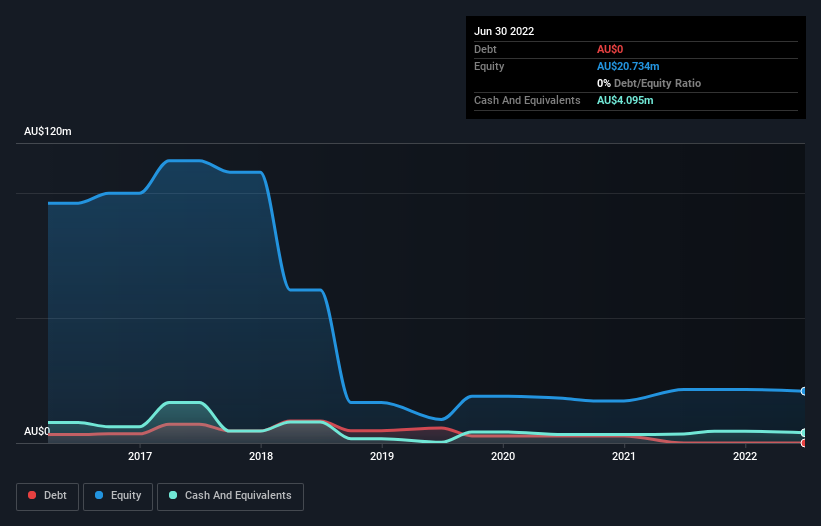We Think Carnegie Clean Energy (ASX:CCE) Can Easily Afford To Drive Business Growth
There's no doubt that money can be made by owning shares of unprofitable businesses. For example, biotech and mining exploration companies often lose money for years before finding success with a new treatment or mineral discovery. Having said that, unprofitable companies are risky because they could potentially burn through all their cash and become distressed.
So should Carnegie Clean Energy (ASX:CCE) shareholders be worried about its cash burn? For the purpose of this article, we'll define cash burn as the amount of cash the company is spending each year to fund its growth (also called its negative free cash flow). We'll start by comparing its cash burn with its cash reserves in order to calculate its cash runway.
Check out our latest analysis for Carnegie Clean Energy
How Long Is Carnegie Clean Energy's Cash Runway?
A cash runway is defined as the length of time it would take a company to run out of money if it kept spending at its current rate of cash burn. When Carnegie Clean Energy last reported its balance sheet in June 2022, it had zero debt and cash worth AU$4.1m. Importantly, its cash burn was AU$51k over the trailing twelve months. So it had a very long cash runway of many years from June 2022. Even though this is but one measure of the company's cash burn, the thought of such a long cash runway warms our bellies in a comforting way. Depicted below, you can see how its cash holdings have changed over time.
How Is Carnegie Clean Energy's Cash Burn Changing Over Time?
In our view, Carnegie Clean Energy doesn't yet produce significant amounts of operating revenue, since it reported just AU$322k in the last twelve months. Therefore, for the purposes of this analysis we'll focus on how the cash burn is tracking. From a cash flow perspective, it's great to see the company's cash burn dropped by 96% over the last year. That might not be promising when it comes to business development, but it's good for the companies cash preservation. Admittedly, we're a bit cautious of Carnegie Clean Energy due to its lack of significant operating revenues. So we'd generally prefer stocks from this list of stocks that have analysts forecasting growth.
Can Carnegie Clean Energy Raise More Cash Easily?
While we're comforted by the recent reduction evident from our analysis of Carnegie Clean Energy's cash burn, it is still worth considering how easily the company could raise more funds, if it wanted to accelerate spending to drive growth. Generally speaking, a listed business can raise new cash through issuing shares or taking on debt. Commonly, a business will sell new shares in itself to raise cash and drive growth. By looking at a company's cash burn relative to its market capitalisation, we gain insight on how much shareholders would be diluted if the company needed to raise enough cash to cover another year's cash burn.
Carnegie Clean Energy has a market capitalisation of AU$31m and burnt through AU$51k last year, which is 0.2% of the company's market value. That means it could easily issue a few shares to fund more growth, and might well be in a position to borrow cheaply.
How Risky Is Carnegie Clean Energy's Cash Burn Situation?
It may already be apparent to you that we're relatively comfortable with the way Carnegie Clean Energy is burning through its cash. In particular, we think its cash burn reduction stands out as evidence that the company is well on top of its spending. But it's fair to say that its cash burn relative to its market cap was also very reassuring. Looking at all the measures in this article, together, we're not worried about its rate of cash burn, which seems to be under control. Separately, we looked at different risks affecting the company and spotted 4 warning signs for Carnegie Clean Energy (of which 2 make us uncomfortable!) you should know about.
If you would prefer to check out another company with better fundamentals, then do not miss this free list of interesting companies, that have HIGH return on equity and low debt or this list of stocks which are all forecast to grow.
Have feedback on this article? Concerned about the content? Get in touch with us directly. Alternatively, email editorial-team (at) simplywallst.com.
This article by Simply Wall St is general in nature. We provide commentary based on historical data and analyst forecasts only using an unbiased methodology and our articles are not intended to be financial advice. It does not constitute a recommendation to buy or sell any stock, and does not take account of your objectives, or your financial situation. We aim to bring you long-term focused analysis driven by fundamental data. Note that our analysis may not factor in the latest price-sensitive company announcements or qualitative material. Simply Wall St has no position in any stocks mentioned.
Join A Paid User Research Session
You’ll receive a US$30 Amazon Gift card for 1 hour of your time while helping us build better investing tools for the individual investors like yourself. Sign up here

 Yahoo Finance
Yahoo Finance 
